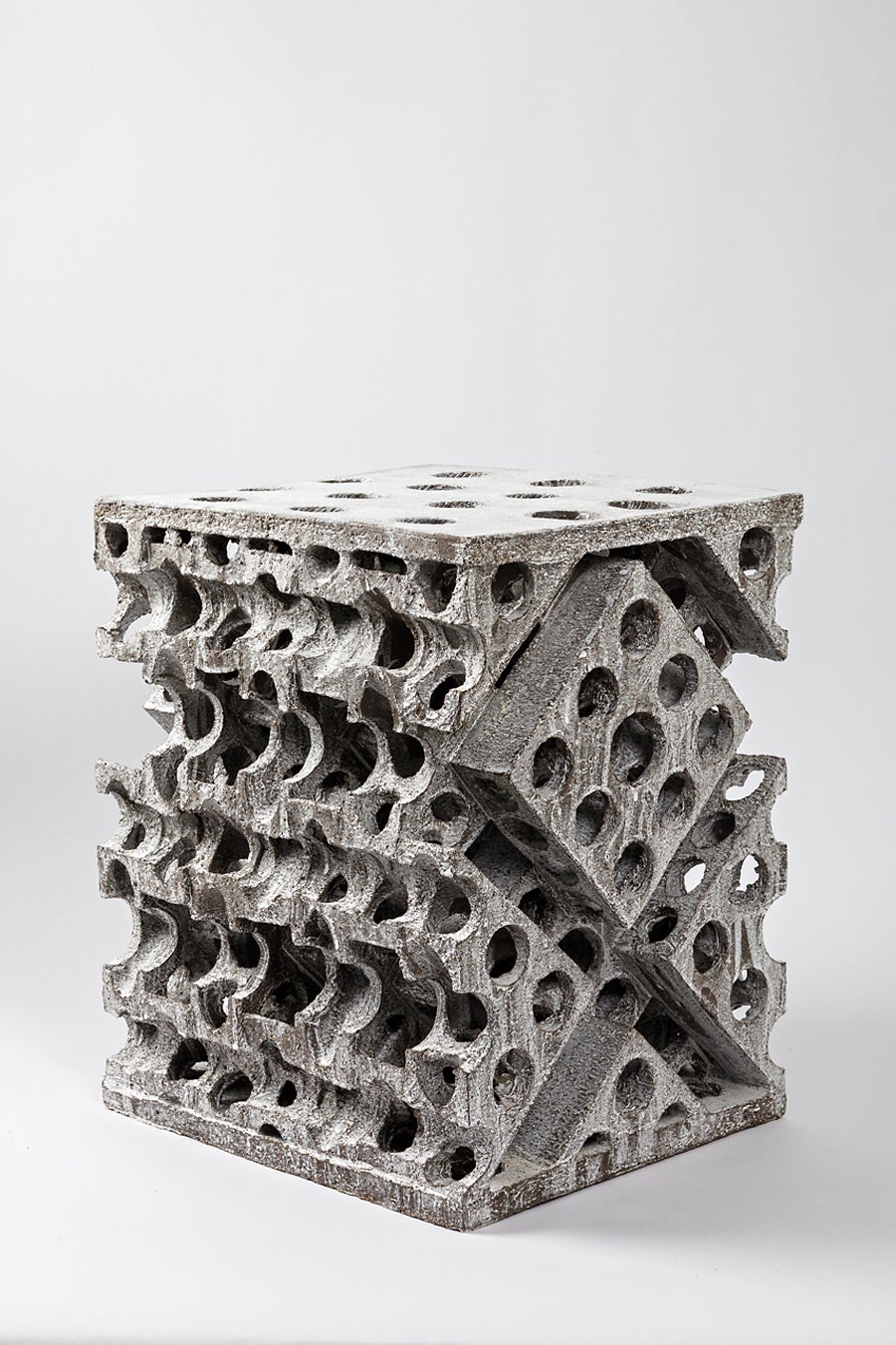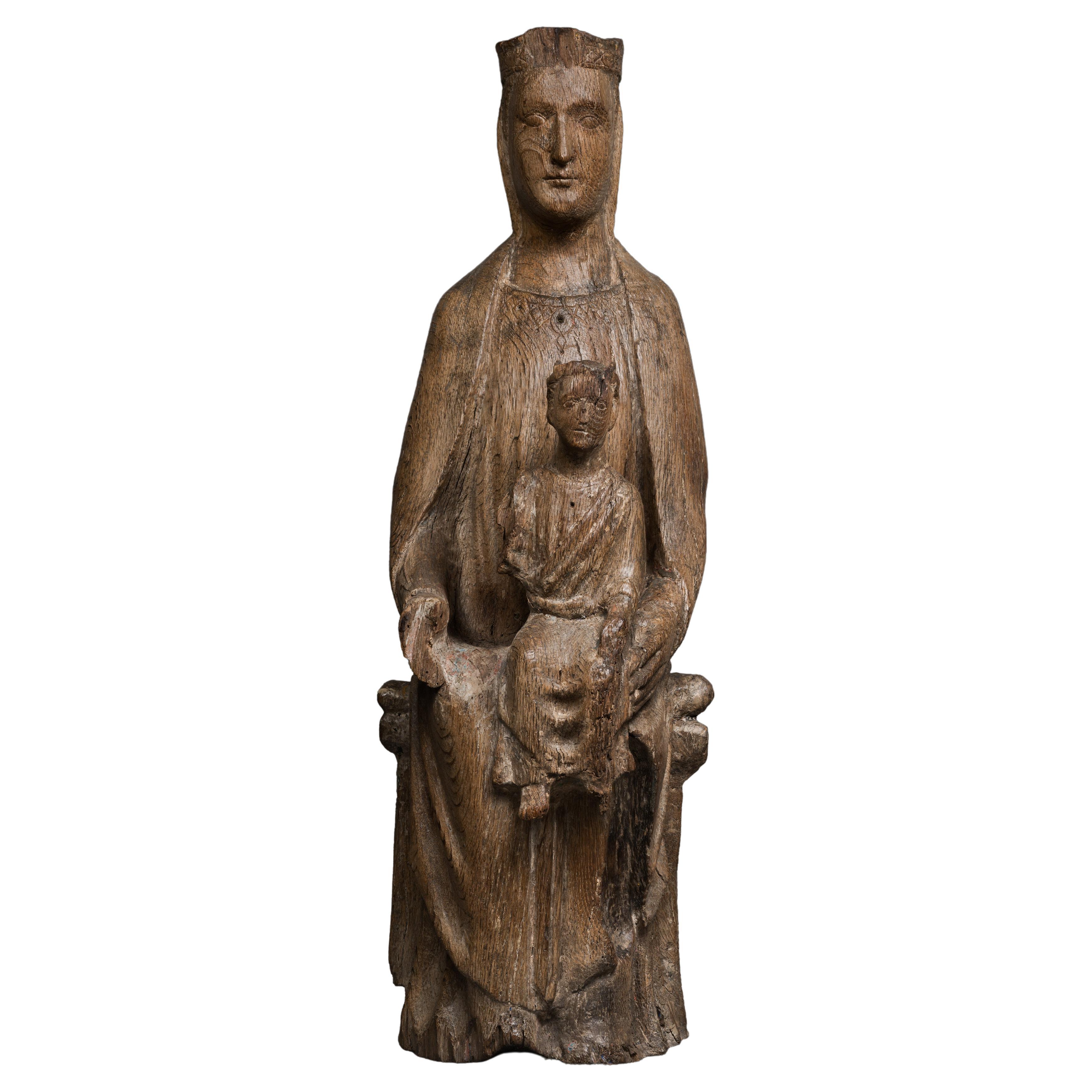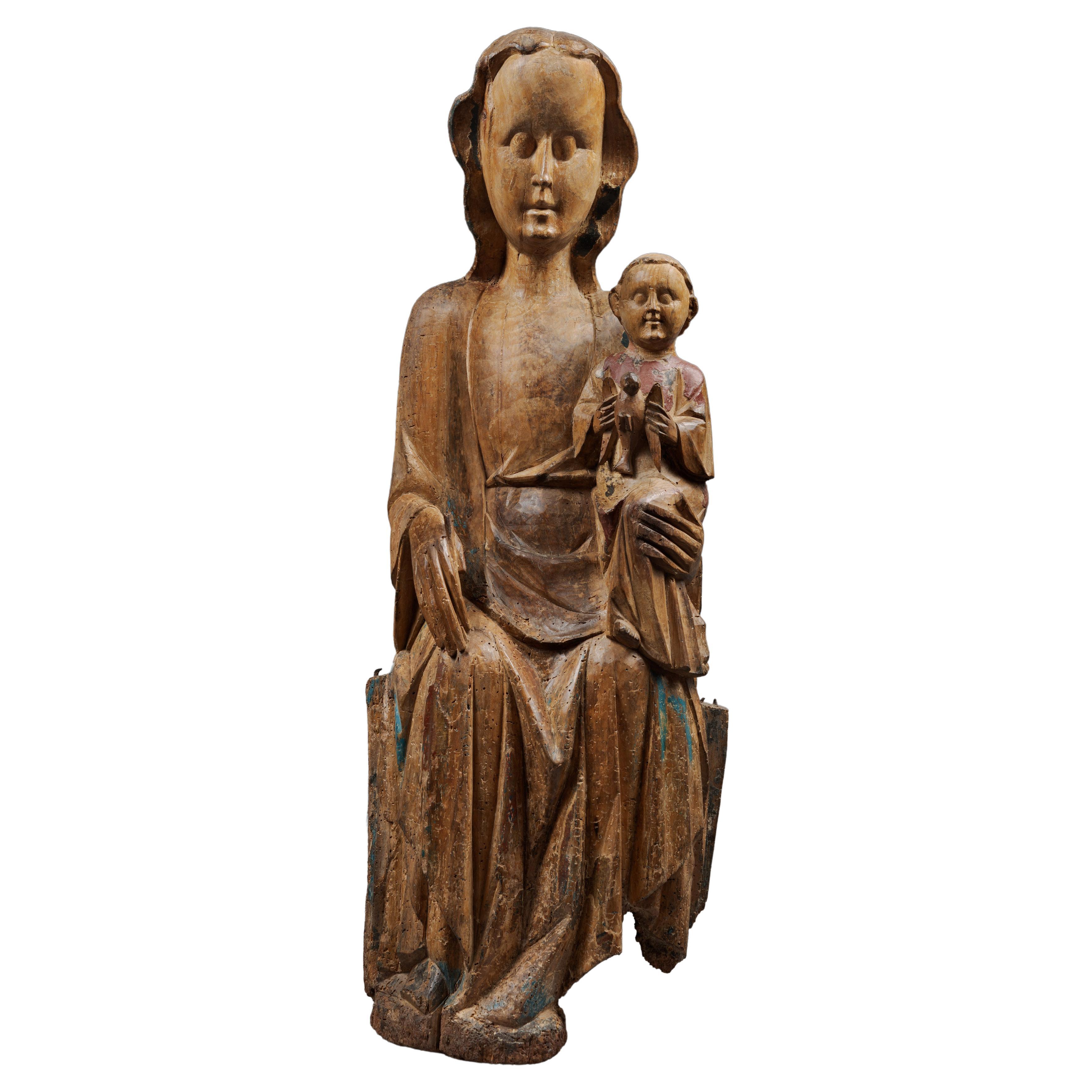Items Similar to Exceptional Virgin and Child in Majesty or "Sedes Sapientiae", Throne of Wisdom
Want more images or videos?
Request additional images or videos from the seller
1 of 5
Exceptional Virgin and Child in Majesty or "Sedes Sapientiae", Throne of Wisdom
About the Item
Exceptional virgin and child in majesty
or “Sedes Sapientiae”, throne of wisdom
Origin: southwestern France.
Period: late 12th - early 13th century.
Height: 46cm
Length: 18cm
Depth: 14.5cm
Walnut wood
Good traces of polychromy
Good condition
From the 12th century onwards Marial devotion becomes paramount. Main intercessor between people and God, the Virgin Mary holds a special position within churches where she seats in majesty. Taking place on a throne-bench she is then figured strictly frontally, her body acting in turn as a throne for her Son the Saviour. She embodies this quote from Saint John of Damascus :
“Her hands will carry the Eternal and her knees will be a throne…”
She is then designated as Sedes Sapientiae meaning Throne of wisdom. This theme of Virgin and Child in majesty was one of the most popular during Middle-Ages. Pilgrimages encouraged it development and the spreading of models all across Europe. We can find examples in France, Germany, Belgium, Scandinavia, England, Italy, Spain,…
This Virgin and Child is seated on throne-bench of which we can see the two jambs. She wears supple draped clothes. The dress is belted at the waist and shows a round collar. The slender vertical pleats are regular. A cloak covers her shoulders.
She presents a beautiful face with delicate features. Her hair is covered with a veil reaching her back.
The Virgin presents the Child Jesus on her knees in a frontal position. The Child is slightly off-centred on His mother’s left knee.
Following the canonical iconography Jesus wears the pallium, a garment worn by the first Christians.
He raises His right hand in a gesture of blessing.
This Virgin and Child is an exceptional sculpture from the late 12th century. As it is common with Romanesque majesties of the first half of the 12th centuries, the attitude is strictly frontal, hieratic with no communication displayed between the mother and the Son. Mary only exists to present her Child, as a Throne of Wisdom. The Child retains a majestic demeanour, blessing the worshippers; an iconography influenced by Byzantine depictions of Christ Pantocrator.
However the position of the Child, slightly off-centred on His mother’s left leg, displays a variation in the iconographical model. This evolution appeared only in the last period of the Romanesque age and thus allows us to date the conception of this statue around the late 12th century. Indeed, it forecasts an evolution that will soon lead artists of the 13th century to depict Christ seated on only one leg of His mother. The perception of Mary herself evolves too and Marial devotion from then on embraces her, not solely as a throne for her Son, but for her own greatness and mightiness.
VIRGIN IN MAJESTY, A SYMBOLIC DEPICTION
Depictions of the Virgin and Child find their origin in a very long tradition going all the way back to pagan deities such as Gallo-Roman mother goddesses. Those depictions appear as a synthesis of previous centuries’ art, answering the devotee’s desire for worshipping and protection.
Since the Council of Nicaea in 352 AD the question of Christ’s true nature is debated. The Council of Ephesus in 431 AD eventually ends the uncertainties by proclaiming His double nature. Christ is both human and godly. Those two essences are united in His person through the mystery of the incarnation. From then on the Virgin Mary is called Theotokos, Mother of God. A vivacious Marial devotion appears and grows for the centuries that succeed.
It is in Western Asia that the first Christians produce the earliest depictions of the Virgin in Majesty. In Europe they are represented in illuminated manuscripts before being carved in stone at the tympanum of cathedrals.
As early as the 9th century the Virgin and Child are carved in wood, in the round, sometimes covered with plaques of precious metals to be offered to the worshipper’s devotion. The oldest one was perhaps the one in Clermont’s cathedral around 946, known thanks to written sources. This statue unfortunately didn’t survive to our days. However it is very likely that it acted as a model for all the Majesties that followed.
The humane and maternal figure of the Virgin Mary allowed a bond of intimacy with the worshippers and came in opposition to the fear raised by God. However, as the mother of the Child God she remains hardly accessible. This dichotomy is particularly evident in the works of the 12th century. As a mother, Mary carries her Son on her laps. As the mother of God, she is the seat of the Divine Wisdom incarnation - Sedes Sapientiae. In this way, the mystery of the incarnation is made understandable to the worshippers, illustrating both the divine and humane nature of Child Jesus.
Regarding Majesties made during the 12th century, the Child is at the centre of focus. Thus the Virgin Mary is here to present the Child. She is subordinated to her Son while as a Mother she embodies the House of David, the human lineage of the Saviour.
This symbolic depiction is rich in meanings. It illustrates the mystery of sacred art. In the spirit of Romanesque period, the Sedes Sapientiae was the tangible representation of the divine hierarchy.
Literature
Abbé Laurentin et René Oursel, Vierges romanes, les vierges assises, Zodiaque, 1988
Jacqueline Boccador, Edouard Bresset, Statuaire médiévale de collection, tome I, Les clefs du temps, 1972
Ilene H. Forsyth, The Throne of Wisdom : Wood sculptures of the Madonna in Romanesque France, Princeton University Press, 1972
Galienne Francastel, Le droit au trône, un problème de prééminence dans l’art chrétien d’Occident du IVe au XIIe s, Paris, Klincksieck, 1973
- Dimensions:Height: 18.12 in (46 cm)Width: 7.09 in (18 cm)Depth: 5.71 in (14.5 cm)
- Materials and Techniques:
- Period:
- Date of Manufacture:Late 12th-Early 13th Century
- Condition:Replacements made: The Christ's head has been replaced.
- Seller Location:Saint-Ouen, FR
- Reference Number:1stDibs: LU3115330451672

About the Seller
5.0
Vetted Seller
These experienced sellers undergo a comprehensive evaluation by our team of in-house experts.
Established in 2016
1stDibs seller since 2017
151 sales on 1stDibs
Typical response time: 7 hours
- ShippingRetrieving quote...Ships From: Saint-Ouen, France
- Return PolicyThis item cannot be returned.
More From This SellerView All
- Important Sedes Sapientiae Virgin and Child also called "Throne of Wisdom"Located in Saint-Ouen, FRIMPORTANT SEDES SAPIENTIAE VIRGIN AND CHILD ALSO CALLED « THRONE OF WISDOM » ORIGIN: FRANCE, BURGUNDY PERIOD: EARLY 13th CENTURY Height : 75 cm Len...Category
Antique 15th Century and Earlier Figurative Sculptures
MaterialsOak
- Virgin and Child "Sedes Sapientiae", Seat of Holy WisdomLocated in Saint-Ouen, FRVirgin and child sedes sapientiae, seat of holy wisdom Origin : Northern Spain, castile, navarre or galicia. Period : early 13th century. Heigh...Category
Antique 15th Century and Earlier Figurative Sculptures
MaterialsWood
- Virgin and Child in MajestyLocated in Saint-Ouen, FRVirgin and child in majesty Origine: castille Epoque: early 14th century Measures: Height: 72cm Length: 30cm Depth: 25cm Polychrome and gi...Category
Antique 15th Century and Earlier Figurative Sculptures
MaterialsWood
- Virgin and Child in Majesty, also known as "Sedes Sapientae"Located in Saint-Ouen, FRVIRGIN AND CHILD IN MAJESTY, ALSO KNOWN AS "SEDES SAPIENTIAE" ORIGIN : SPAIN, CATALOGNE PERIOD: EARLY 13th CENTURY Height : 95 cm Width : 32 cm Depth : 28 cm Softwood No polychromy In the middle of the 12th century, the Virgin took her place in churches, seated in Majesty, serving as a throne for her son Jesus. She is then called Sedes Sapientiae, meaning the Throne of Wisdom. At that time, she is not represented for herself and only exists because she has been designated as Theotokos, the mother of God, at the Council of Ephesus in 431, where the divine nature of Christ was proclaimed from his birth. The upright and perfectly hieratic bust of this Virgin and Child in Majesty is seated on a throne-bench. She is dressed in a tunic with a rounded neckline and covered with a fine mantle placed on her narrow shoulders. The supple and natural drapery follows the lines of the body. Large curls frame her face with delicate and regular features, a long straight nose, almond-shaped eyes, and small lips. She supports the Infant Jesus with her left hand. Like his mother, he is dressed in a long tunic, and his little feet are visible in the folds. He holds a small sphere in his left hand, while with his right hand, he gestures in blessing. The face of Christ bears a strong resemblance to his mother’s one, and he gives a slight smile. The position of the Child is no longer as hieratic, nor frontal or central as in the early 12th century, but his face still turns towards the faithful. The 13th century indeed emerges as a period of transition in the artistic domain. The statuary, while retaining certain characteristics still belonging to the habits of the previous century, also develops new formal solutions. As a result, Mary maintains a hieratic and frontal position, while her son shifts to place himself well to the left on her knee. Similarly, while the Virgin seems perfectly still, Jesus, on the other hand, appears much more animated, especially in the positioning of his hands. His left hand holds the orb, and judging by the raised right arm directed towards the faithful, one can easily imagine that he was making a gesture of blessing. The influence of the Sedes Sapientiae from previous centuries still seems particularly prevalent in this work. These few characteristics allow dating this Spanish Virgin...Category
Antique 15th Century and Earlier Spanish Gothic Figurative Sculptures
MaterialsSoftwood
- Important Virgin and Child in MajestyLocated in Saint-Ouen, FRImportant virgin and child in majesty Origin : Germany Or Eastern France Époque : Second Half Of The 13th Century Height: 104.5 cm Length: 3...Category
Antique 15th Century and Earlier Figurative Sculptures
MaterialsOak
- Virgin and Child in Majesty with a BirdLocated in Saint-Ouen, FRVirgin and child in majesty with a bird Origin: Southern Germany Or Austria Period: Late 13tth - Early 14th Century Height : 87.5 cm Length : 32 cm Depth : 19 cm Lime ...Category
Antique 15th Century and Earlier Figurative Sculptures
MaterialsWood
You May Also Like
- Seated Virgin with Child (Sedes Sapientiae) from the 12th Century in SpainLocated in Madrid, ESTechnique: Tempera and oil on wood Dimensions: 25 x 11 x 8 cm Description: This exceptional work from the 12th century represents the Seated Virgin with Child (Sedes Sapientiae), standing out as an artistic treasure from medieval Spain. The portrayal of the Virgin enthroned with the Child on her lap is emblematic of Romanesque art, and this particular piece is a valuable and authentic example of that era. The current polychromy belongs to the Gothic period and overlays the original Romanesque layer. It is crucial to highlight that the current state of the artwork is the original, without any cleaning interventions, imparting a unique authenticity. The work exhibits architectural characteristics typical of Romanesque art, evident in the sides of the throne. The rigidity and symmetry characteristic of this style are reflected in the firm presentation of the Baby Jesus, noticeable in his gesture while holding his son. The Virgin wears a crown, symbolizing her royal character as the Queen of Heaven and Creation. Both figures retain traces of polychromy on the face and attire, adding layers of history and authenticity. While similar Romanesque Virgin...Category
Antique 15th Century and Earlier Figurative Sculptures
MaterialsFruitwood
- Antique Enthroned Virgin Mary and ChildLocated in Doha, QAThis extraordinary museum piece Enthroned Virgin Mary with the child on her lap comes from the Rhone region in France. The saint symbol and protector ...Category
Antique 15th Century and Earlier French Gothic Figurative Sculptures
MaterialsWood, Walnut
- Georges Jouve Virgin and Child, 1944By Georges JouveLocated in Saint Ouen, FRGeorges Jouve Virgin and child Black glazed ceramic with iridescent metallic luster Bears the signature on the back as well as the alpha symbol, c...Category
Vintage 1940s French Figurative Sculptures
MaterialsCeramic
- Ceramic Virgin with ChildLocated in grand Lancy, CHCeramic virgin with child.Category
Vintage 1950s European Figurative Sculptures
MaterialsCeramic
- A Polychrome and Parcel-Gilt Marble Group of the Virgin and ChildLocated in London, GBA Polychrome and Parcel-Gilt Marble Group of the Virgin and Child Attributed to Giovanni Di Balduccio (1317 - 1349) Marble Italy Circa 1330 - 1340 SIZE: 65cm high, 28cm wide - 25½ i...Category
Antique 15th Century and Earlier Italian Figurative Sculptures
MaterialsMarble
- Large Virgin and Child in polychrome wood, Spain, 16th CenturyLocated in PARIS, FRLarge painted and carved wooden Virgin and Child in the round, representing the Virgin and Child carrying the globe. The theme of the Virgin and Child is the most represented in all ...Category
Antique 1630s Spanish Renaissance Figurative Sculptures
MaterialsWood





